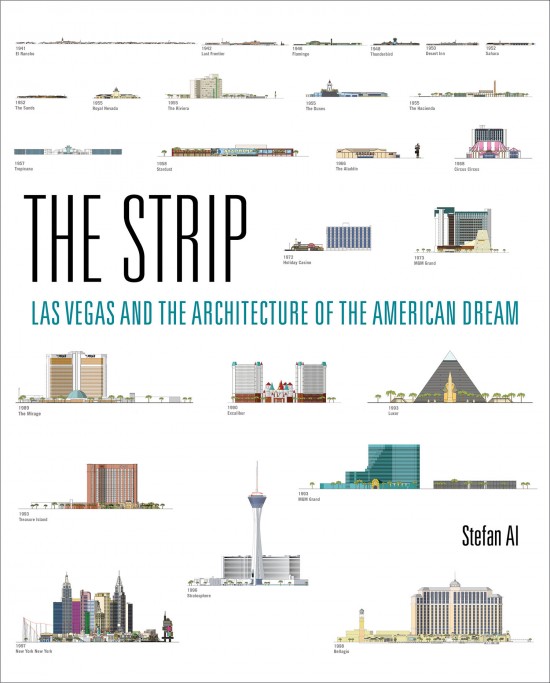The Strip
The Strip: Las Vegas and the Architecture of the American DreamStephen AlThe MIT Press, March 2017 Hardcover | 8 x 10 inches | 272 pages | 72 illustrations | English | ISBN: 9780262035743 | $34.95 PUBLISHER'S DESCRIPTION: The Las Vegas Strip has impersonated the Wild West, with saloon doors and wagon wheels; it has decked itself out in midcentury modern sleekness. It has illuminated itself with twenty-story-high neon signs, then junked them. After that came Disney-like theme parks featuring castles and pirates, followed by replicas of Venetian canals, New York skyscrapers, and the Eiffel Tower. (It might be noted that forty-two million people visited Las Vegas in 2015—ten million more than visited the real Paris.) More recently, the Strip decided to get classy, with casinos designed by famous architects and zillion-dollar collections of art. Las Vegas became the “implosion capital of the world” as developers, driven by competition, got rid of the old to make way for the new—offering a non-metaphorical definition of “creative destruction.” In The Strip, Stefan Al examines the many transformations of the Las Vegas Strip, arguing that they mirror transformations in America itself. The Strip is not, as popularly supposed, a display of architectural freaks but representative of architectural trends and a record of social, cultural, and economic change. Al tells two parallel stories. He describes the feverish competition of Las Vegas developers to build the snazziest, most tourist-grabbing casinos and resorts—with a cast of characters including the mobster Bugsy Siegel, the eccentric billionaire Howard Hughes, and the would-be political kingmaker Sheldon Adelson. And he views the Strip in a larger social context, showing that it has not only reflected trends but also magnified them and sometimes even initiated them. Generously illustrated with stunning color images throughout, The Strip traces the many metamorphoses of a city that offers a vivid projection of the American dream. Stefan Al, a Dutch architect and urban designer, is Associate Professor of Urban Design at the University of Pennsylvania. His books include Villages in the City and Mall City. REFERRAL LINKS: dDAB COMMENTARY: On page 100 of The Strip, Stefan Al references a local paper that announced in 1968, "Yale Professor Will Praise Strip for $8,925," the amount corresponding to a study grant requested by Robert Venturi and Denise Scott Brown. Al also mentions that the couple, with their students from Yale, were in attendance at that time at the opening of Circus Circus, the casino created by developer Jay Sarno to attract the masses rather than the classy people he targeted with Caesars Palace, which opened a couple years earlier elsewhere on the Vegas Strip. It's extraordinary that Learning from Las Vegas — the 1972 book by Venturi, Scott Brown, and Steven Izenour that remains the book architects associate with Vegas — is not discussed in Al's book until page 100, between histories of Circus Circus and Landmark, a fifteen-story tower built in 1969 but imploded in 1995. But given that The Strip is strictly chronological, describing nearly forty casinos that were built on The Strip between 1941 and 2010, it makes sense that the influential book is discussed when it was being researched, in 1968, at the tale end of what Al calls the "Pop City" phase of the Vegas Strip. "Pop City" is one of seven chapters in The Strip that describe the major buildings on the Vegas Strip in increments of between five to twenty years. The book begins with the "Wild West" in the years of World War II, when Thomas Hull opened El Rancho and spurred other Western-themed resorts, and it ends with this century's preference for "Starchitecture," most evident at CityCenter, where buildings by Norman Foster, Helmut Jahn, Daniel Libeskind, and others congeal into a mess of glass and metal. Clearly these and the other chapters are thematic as well as chronological, reflecting the changes of style and taste that evolved over time and led to constant transformations of The Strip, a place always driven by money and therefore embodying the American ethos of "out with the old, in with the new." The Strip from the Learning from Las Vegas era is visible in the third chapter, "Pop City," with the famous signs of the Stardust and Caesar's, but to venture outside of familiar territory architects should head to the other chapters to learn about, for instance, the earlier, relatively modest resorts and casinos after World War II or the awkward decades between the 1960s "Pop" and what Al calls "Sim City," starting in the 1990s. Seven maps coinciding with the seven chapters are printed on the endpapers, clearly expressing (along with the cover) the enlargement of The Strip and the buildings on either side of the famous thoroughfare. More than that, the maps are a handy key to the buildings described in Al's enjoyable architectural and social history of The Strip

Stephen Al
The MIT Press, March 2017








